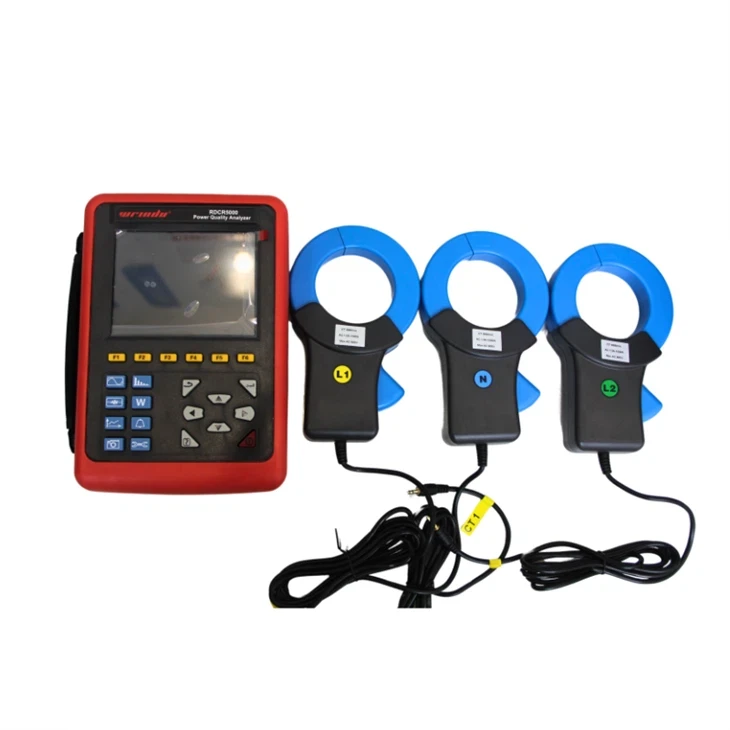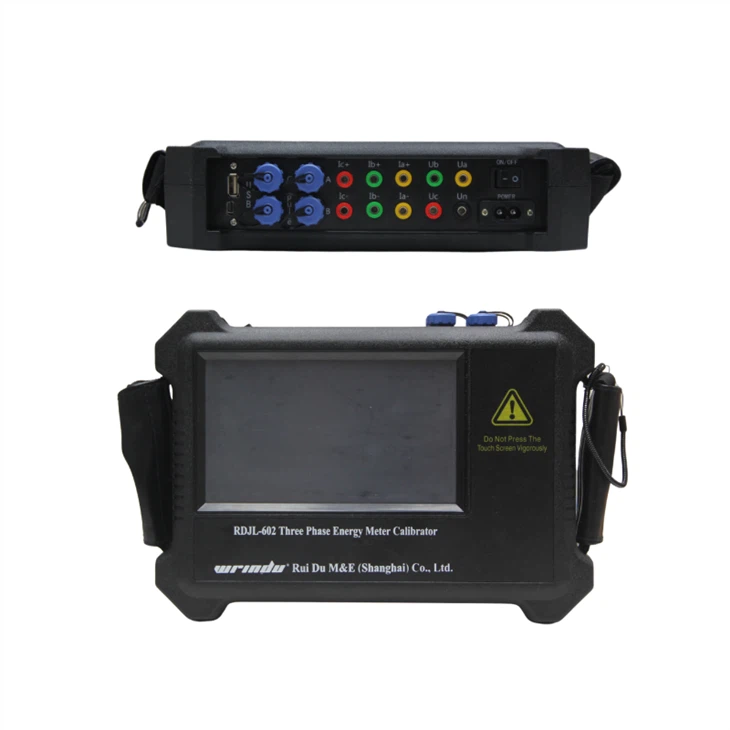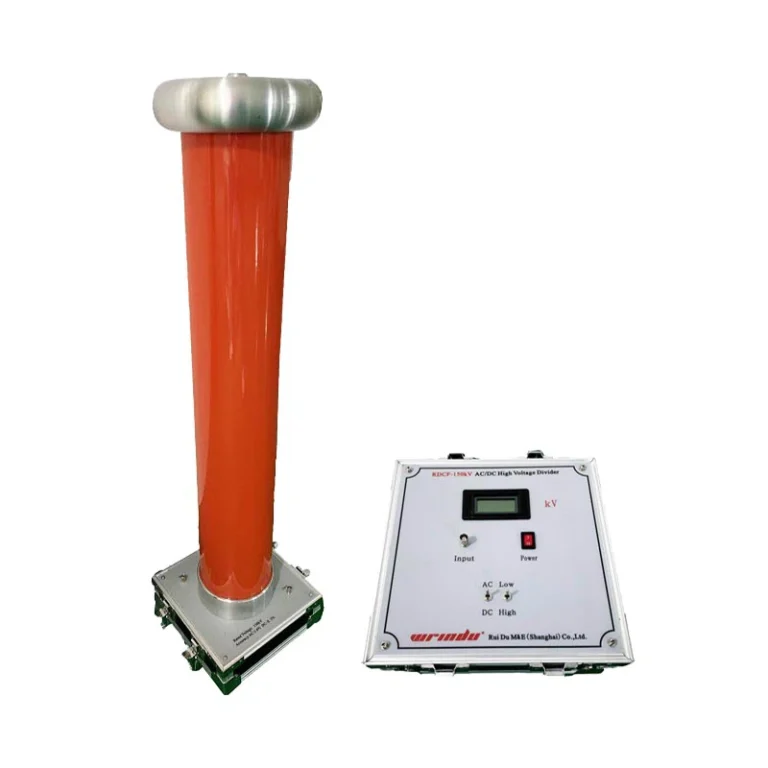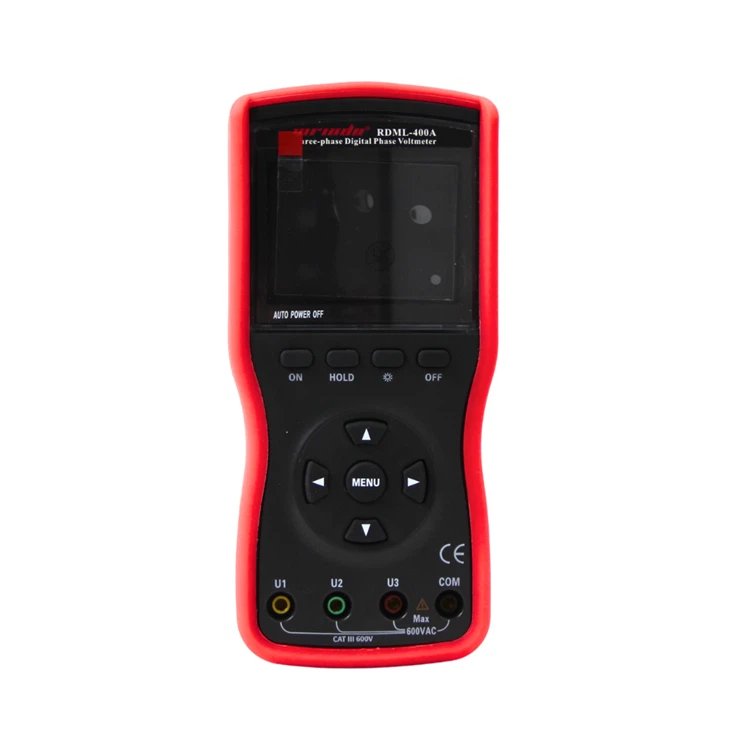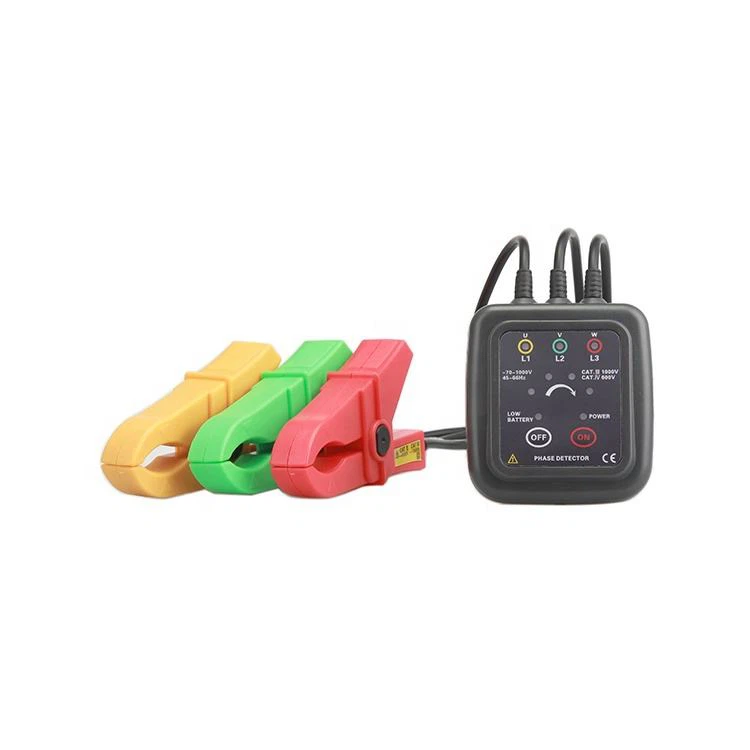Other electrical testing products and accessories
As a Power Meter manufacturer, Wrindu has established a mature team covering all aspects of R&D, production, sales, and service after more than ten years of development. Currently, we provide high-quality testing equipment to the power industry in over 50 countries, including the Ethiopian Electric Power Company, Uganda Electric Power Company, and Dubai Electricity Company. In addition to our own brand products, we also offer professional OEM and ODM customization services tailored to our customers’ specific needs. For more product information or any special requests, please feel free to contact us. We are committed to providing you with professional pre-sales and after-sales services.
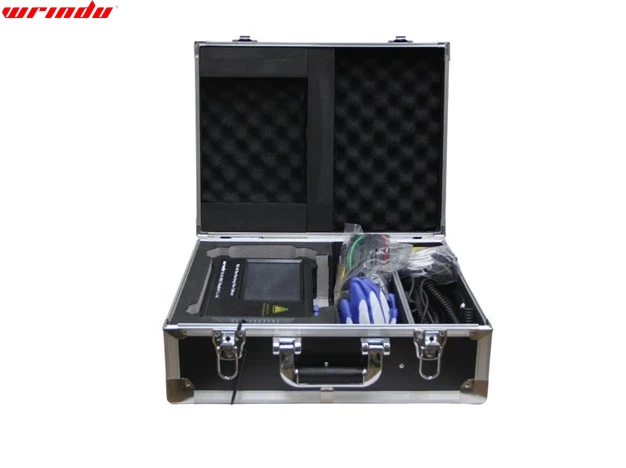
What Is Power Meter ?
The power quality analyzer is a high-precision testing instrument designed to accurately detect and evaluate power quality issues within the electrical grid, including waveform distortion, harmonic content, and phase unbalance. This device not only performs electrical parameter testing but also has the capability of vector analysis, providing users with a comprehensive assessment of power quality. With the widespread application of power electronics technology, the analyzer has become a key tool for identifying and resolving power supply pollution issues caused by nonlinear loads, impulse loads, and unbalanced electrical consumption characteristics. It is suitable for applications such as rectifiers, variable frequency drives, electric arc furnaces, electrified railways, and more. It helps prevent voltage instability, overvoltage, and harmonic issues, improving the efficiency of power generation, transmission, and utilization, reducing equipment overheating, vibration, and noise, extending the life of insulation, preventing equipment failures or burnouts, and ensuring the safe, stable, and economic operation of the power system.
What are advantages of Power Meter ?
Real-time monitoring function
The real-time monitoring function ensures accurate detection of key indicators such as voltage, current, power factor, and harmonics. During the monitoring process, the system intelligently analyzes these parameters. If the monitored data exceeds the predefined safety thresholds, the equipment will promptly trigger an alarm mechanism, immediately notifying the relevant personnel so that they can take swift action accordingly.
Intuitive visual operation
Equipped with a 5.6-inch LCD color screen with high resolution, it clearly displays the parameters of each phase, waveform diagrams, phasor diagrams, and harmonic ratio charts in different colors, allowing the operator to understand the operational status of the power grid more intuitively and efficiently.
Efficient data processing
The device uses a DSP+ARM dual-processor architecture, where the DSP processor focuses on data acquisition and algorithm processing, while the ARM processor handles communication protocols and human-machine interface processing. This ensures the efficiency of data processing and the precision of monitoring, allowing for real-time monitoring of complex changes in the power grid.
Large capacity data storage
The built-in flash memory can store up to 60 screen captures and 150 transient voltage/current waveform captures. It also has the capacity to store 12,800 alarm logs. Equipped with a 2G memory card, it can record trend curve data for up to 20 electrical parameters over a period of 300 days, providing comprehensive data support for power system analysis and fault troubleshooting.
Types of Power Meter
Power quality analyzer
The power quality analyzer is a portable detection device specifically designed for evaluating and monitoring the operational quality of power grids. It provides harmonic analysis and power quality analysis during the operation of electrical systems, ensuring the stability and efficiency of the grid. The instrument is capable of long-duration data collection and monitoring to capture detailed information about the grid’s operation. Additionally, paired with specialized power quality data analysis software, it can upload measurement data to a computer for in-depth analysis, helping users to fully understand the performance of the grid and detect potential issues in a timely manner. In summary, the power quality analyzer is a key tool for detecting and analyzing the operational quality of power grids, ensuring the reliability of electrical systems.
Three Phase Energy Meter Calibrator
The three-phase electric energy meter on-site calibration device is a portable instrument specifically designed for on-site testing in power systems. It is primarily used to verify the operational errors of electric energy meters and to detect the correctness of the wiring in measuring devices. The instrument can conduct on-site tests of the meter’s error, accuracy, latent movement, and start-up performance without interrupting the power supply. Additionally, it measures key parameters of the power grid such as voltage, current, active power, reactive power, and power factor, as well as detecting the transformation ratio and polarity of current transformers. Moreover, the three-phase electric energy meter on-site calibration device can analyze power quality, including voltage harmonics, current harmonics, voltage balance, and total harmonic distortion, to determine if there is any electricity theft, whether the measurement accuracy meets national standards, and the impact of users on grid quality. Through these comprehensive tests, the instrument provides power measurement personnel with effective data support, ensuring the safe operation of the power system and the fairness of energy measurement.
Application of Power Meter
01/ Electric Power System Health Monitoring
Utilizing a power quality analyzer, it is possible to track key parameters such as voltage, current, frequency, and power in real-time within the power grid, providing immediate feedback on the overall operational status of the electrical system.
02/ Harmonic Pollution Assessment
The analyzer can accurately measure the harmonic components of the power grid, including their frequency, amplitude, and phase information, to evaluate the degree of harmonic pollution in the grid.
03/ Power Performance Analysis
Through in-depth analysis of active power, reactive power, apparent power, and power factor, the power quality analyzer assists users in understanding the power quality condition of the electrical system.
04/ Electric Energy Loss Assessment
The analyzer can quantify losses caused by power quality issues, helping users calculate costs related to energy waste.
05/ Fault Detection and Analysis
In the event of an abnormality in the power system, the device can record and analyze fault phenomena, such as voltage surges, sags, or transient overvoltages, providing data support for fault identification and prevention.
06/ Equipment Protection Function
The power quality analyzer is equipped with protective thresholds; it can quickly trigger alarms or implement protective measures when grid parameters exceed established limits, thereby preventing equipment damage.
How to maintain Power Meter ?
Environmental conditions
Do not work alone or in explosive gas, steam or high dust environment.
Voltage check
Before testing, make sure that the tester voltage display is not higher than 36V.
Power off of the product under test
Confirm that the tested device is in a power-off state. This instrument is not allowed to be used to test live device.
Voltage range determination
Confirm that the withstand voltage of the tested device is within the output voltage range of theselected test gear.
Components of Grounding And Insulation Resistance Tester
Outside case
Charge interface
USB interface
Touch colorful screen
Function selection button
Measurement range selection switch
Compared with traditional Power Meter , our this product
1. All-in-One Field Testing Solution
This comprehensive testing instrument not only possesses the capability to test three-phase electrical parameters but also integrates multiple testing functions, offering a versatile and intelligent testing experience. It meets various field testing requirements in electrical engineering, power system maintenance, and equipment repair, significantly enhancing work efficiency and eliminating the hassle of carrying multiple devices.
2. Ultimate User Interaction Experience
Equipped with an oversized LCD color screen and high-resolution display technology, it not only provides clear and detailed image display but also ensures data can be read clearly in bright or dim environments. The simple and intuitive interface design allows even those unfamiliar with the instrument to quickly get the hang of it, greatly enhancing the user experience.
3. Barrier-Free Cross-Cultural Operation
The device features a built-in bilingual operation interface in both Chinese and English, catering to the operation habits of users from different language backgrounds and reflecting the international perspective of the product design. Whether it’s for domestic users or overseas engineers, they can easily operate the device based on their language preference, truly achieving global versatility for the testing equipment.
4. Durability and Stability
The carefully designed anti-vibration structural shell effectively absorbs and withstands external impacts and vibrations, ensuring the instrument remains stable and operational in complex and changing field environments, thus extending the equipment’s lifespan. This robust and durable design makes the instrument an ideal choice for long-term outdoor work.
FAQ
Q: What is the purpose of a power analyzer?
A: The primary function of a power analyzer is to accurately measure and assess the flow of electrical power within an electrical network. It quantifies this flow in terms of power, typically expressed in units of watts (W) or kilowatts (kW), which represent energy transfer rates of joules per second (J/s). Essentially, a power analyzer serves to determine how efficiently electrical energy is being transmitted between different points in an electrical system over a given time period, providing critical insights into system performance and energy consumption.
Q: How do you measure power quality?
A: To evaluate the power quality, a practical starting point is to measure the voltage and frequency with tools like a multimeter. This helps pinpoint any variations from standard voltage and frequency levels, indicating potential power quality issues.
Q: What is the main purpose of power quality analysis?
A: The primary goal of power quality analysis is to ensure the reliability and optimal performance of a building or facility’s electrical system. It involves examining factors like power flow, grounding, and harmonic distortion to gauge the integrity of the electrical power supply.
Q: What is the difference between power meter and power Analyser?
A: The distinction between a power meter and a power analyzer lies in their precision and functionality. Power analyzers are known for their high accuracy and extensive range of capabilities, making them more complex instruments. They are typically employed in professional settings for research and development work, as well as for end-of-line testing.
Q: What is the standard of power quality?
A: Power quality standards act as benchmarks for assessing the electrical power supply’s performance. They provide a uniform method for measuring and interpreting power quality, help in pinpointing existing issues, and guarantee that power systems adhere to defined quality and reliability criteria.
Q: What are the benefits of power quality analyzer?
A: A power quality analyzer offers significant benefits by flagging potential issues early, thereby preventing equipment failures that lead to downtime and expensive repairs, while also pinpointing ways to cut energy consumption through efficiency improvements.
Q: Is power quality equal to voltage quality?
A: Power quality encompasses more than just voltage quality; it’s a broader term that includes both current and voltage qualities, considering the dynamic relationship between the electrical system and its loads. Voltage quality specifically refers to how closely the actual voltage waveform matches the ideal smooth, sinusoidal pattern with consistent magnitude and frequency.
Q: How can power quality problems be detected?
A: Power quality issues can be detected using specialized tools known as power quality analyzers and loggers. These devices are essential for pinpointing common power disturbances, ensuring that no critical event goes unnoticed. Whether conducting a simple system review or an in-depth power quality analysis, the reliability of the data collected is crucial.
Q: Why do we measure power quality?
A: We measure power quality to understand the root causes of disturbances within the electrical system. Having clear and accurate data is vital for making informed decisions to correct and prevent issues, ensuring the reliable operation of equipment, and the prevention of future malfunctions.
Q: What is poor power quality?
A: Poor power quality refers to an inconsistent electrical supply, often outside of acceptable tolerance levels, leading to a range of issues. Understanding the causes of poor power quality is key to addressing problems such as financial losses and failure to meet industrial standards.
Q: What are four 4 factors that contribute to power quality?
A: Four key factors affecting power quality are as follows:
1. Power factor issues, reflecting the efficiency of power conversion to useful work.
2. Harmonic distortion, which modifies the electrical waveform from its ideal sinusoidal shape.
3. Voltage fluctuations, involving variations in voltage that can disrupt equipment operation.
4. Transient overvoltages, sudden voltage spikes that can cause damage to electrical systems.
Q: What are the characteristics of good power quality?
A: Good power quality is characterized by a consistent and stable power supply to electrical equipment, free from issues like voltage dips, surges, harmonics, and electrical interference. It prevents damage to machinery, maintains high efficiency, and minimizes downtime and maintenance expenses.
Q: What are the parameters used to describe power quality?
A: Power quality is described using parameters such as voltage, current, frequency, harmonics, transients, and more, which are monitored to assess and analyze the health of electrical systems, ensuring standards are met and optimizing system performance.




